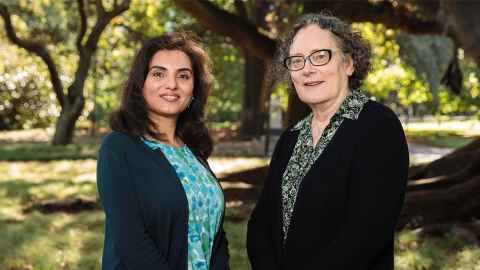University experiment mimics Covid-19
24 August 2021
A virus transmission experiment at the University of Auckland uses a framework called Safe Blues, where virtual tokens are spread via Bluetooth between the phones of participants.

An experiment running at the University of Auckland can provide near-real-time information on the likely spread of Covid-19.
In the experiment, virtual - not real - viruses are spread within an Android app that members of the experiment run on their phone. This virus transmission experiment uses a framework called Safe Blues, where virtual tokens are spread via Bluetooth between the phones of participants.
When students taking part in the experiment are physically close to each other, their phones exchange tokens which then spread, mimicking the dynamics of the real epidemic. This allows researchers to estimate the spread rate of a real virus.
Safe Blues involves hundreds of digital token variants with varying disease attributes. For example, one set of variants has a random incubation period with a mean of 3 days, and a random disease duration (during which a phone can infect other phones) with a mean of 10 days. This is similar to Covid-19.
Following the rapid Auckland lockdown, the Safe Blues experiment is already giving signals showing that the lockdown works to inhibit the spread of both Covid-19 as well as Safe Blues strands.
If participants are socially distant and do not interact, then neither the Covid-19 virus nor the Safe Blues tokens can propagate.
The researchers running Safe Blues use statistics and machine-learning techniques to predict what is happening. Each phone running the app carries many different “strands” of virtual Covid-19. It is the combination of the strands that gives the experiment the ability to predict how the virus is spreading in real life.
The recent delta outbreak is very concerning given the rising numbers in parts of nearby Australia, says Safe Blues researcher Dr Azam Asanjarani from the University of Auckland’s Department of Statistics.
“Following the rapid Auckland lockdown, the Safe Blues experiment is already giving signals showing that the lockdown works to inhibit the spread of both Covid-19 as well as Safe Blues strands,” she says.
“Safe Blues can tell us about contact trends to help learn about the overall rate of virus spread and the effect of social distancing in controlling it. We can already see that Safe Blues is able to reflect the current state of the pandemic under lockdown.”
Now, after five full days of lockdown, the system’s live measurements are already showing that the number of exposed participants is decreasing, as reflected in the number of incubating participants. However, the number of infected participants remains constant. Safe Blues is showing that the transmission rate on the University's city campus has fallen to negligible levels, mirroring what's happening in the real world.
With real Covid cases, one cannot measure exposed cases, and hence the effect of the lockdown is not yet visible on the actual case numbers in New Zealand. Safe Blues allows us to immediately see the actual effect of lockdown measures - in the subset of the population that has the app on their devices.
Media contact
Anne Beston | Senior Media Adviser
Communications Office
DDI: 09 923 3258 Mob: 021 970 089
Email: a.beston@auckland.ac.nz